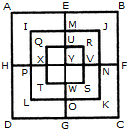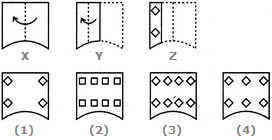Discussion
Home ‣ Non Verbal Reasoning ‣ Analytical Reasoning See What Others Are Saying!
- Question
Count the number of squares in the given figure.

Options- A. 8
- B. 12
- C. 15
- D. 18
- Correct Answer
- 15
ExplanationThe figure may be labelled as shown.
The simplest squares are QUYX, URVY, YVSW and XYWT i.e. 4 in number.
The squares composed of two components each are IMYP, MJNY, YNKO and PYOL i.e. 4 in number.
The squares composed of three components each are AEYH, EBFY, YFCG and HYGD i.e. 4 in number.
There is only one square i.e. QRST composed of four components.
There is only one square i.e. IJKL composed of eight components.
There is only one square i.e. ABCD composed of twelve components.
Total number of squares in the given figure = 4 + 4 + 4+1 + 1 + 1 = 15.
More questions
- 1. Select the alternative which represents three out of the five alternative figures which when fitted into each other would form a complete square.

Options- A. 134
- B. 145
- C. 125
- D. 124 Discuss
Correct Answer: 145
Explanation:

- 2. Find the question mark ? figure from answer figure.
Options- A. 1
- B. 2
- C. 3
- D. 4 Discuss
Correct Answer: 2
Explanation:
From first figure to second figure one box each is deleted from all the four sides.
- 3. NA
Options- A. 1
- B. 2
- C. 3
- D. 4 Discuss
Correct Answer: 1
Explanation:
NA
- 4. In each of the following questions which of the answer figures is exactly the mirror image of the question figure when the mirror is held at the given point
Options- A. 1
- B. 2
- C. 3
- D. 4 Discuss
Correct Answer: 3
Explanation:
As per the given above question figure ,
Figure ( 3 ) of the answer figures is exactly the mirror image of the given original image across the given line , Because given image will become opposite to the given line MN.So , correct answer is option C .- 5. Select a figure from amongst the Answer Figures which will continue the same series as established by the five Problem Figures.
Problem Figures: Answer Figures:
 (A) (B) (C) (D) (E) (1) (2) (3) (4) (5)
(A) (B) (C) (D) (E) (1) (2) (3) (4) (5)
Options- A. 1
- B. 2
- C. 3
- D. 4
- E. 5 Discuss
Correct Answer: 4
Explanation:
The line segment rotates through 90 o and moves to the adjacent portion of the rhombus in an ACW direction in first, third, fifth, ... steps. The other symbol moves to the adjacent portion of the rhombus in an ACW direction and also gets replaced by a new symbol in second, fourth, sixth,... steps.- 6. Identify the figure that completes the pattern.
 (X) (1) (2) (3) (4)
(X) (1) (2) (3) (4)
Options- A. 1
- B. 2
- C. 3
- D. 4 Discuss
Correct Answer: 3
Explanation:

- 7. CAT2015
Options- A. .
- B. .
- C. .
- D. . Discuss
Correct Answer: .
Explanation:
Answer C
- 8. A piece of paper is folded and cut as shown below in the question figures. From the given answer figures, indicate how it will appear when opened.
Options- A. 1
- B. 2
- C. 3
- D. 4 Discuss
Correct Answer: 3
Explanation:
NA
- 9. NA
Options- A. 1
- B. 2
- C. 3
- D. 4 Discuss
Correct Answer: 2
Explanation:
NA
- 10. Choose a figure which would most closely resemble the unfolded form of Figure (Z).

Options- A. 1
- B. 2
- C. 3
- D. 4 Discuss
Correct Answer: 3
Comments
There are no comments.
- 1. Select the alternative which represents three out of the five alternative figures which when fitted into each other would form a complete square.
Programming
Copyright ©CuriousTab. All rights reserved.
